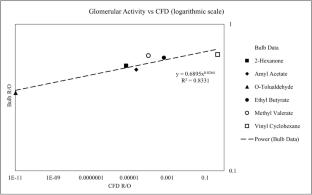Odor perception can be achieved through ortho or retronasal routes, with the latter being an important component of flavor perception. There are significant olfactory differences that exist between rats and humans and by understanding the role of structural differences, further insight can be gained into the mechanism of odorant perception via ortho or retronasal routes.
3D human and rat (Sprague–Dawley) computational models were used to investigate nasal anatomy impact on ortho vs. retronasal odorant transport to the olfactory epithelium. The nasal pharynx region was modified for human and rat models to probe nasal structure impact on ortho vs. retro olfaction. Sixty-five odorant absorption rates to the olfactory epithelium were extracted from each model.
The retronasal route provided higher peak odorant absorption compared to orthonasal route for human (left: 90% higher, right: 45% higher), but substantially lowered peak absorption for rat (medial: 97% lower, lateral: 75% lower). For both models, anatomical modification had minimal impact to orthonasal routes, but substantially modulated the retronasal route: decrease (left: − 41.4%, right: − 44.2%) for human, and increase to the medial (29.5%) but not to lateral (− 14.3%) for rat.
There exist key differences between humans and rats regarding retro/orthonasal odorant transport routes, which matched well with experimental olfactory bulb activity data in literature.
While humans have equivalent odorant delivery between routes, the difference in retro and orthonasal routes in rodents is substantial and changes to the transverse lamina above the nasopharynx can substantially modulate the retronasal route, but not enough to bridge the gap between the two routes.



